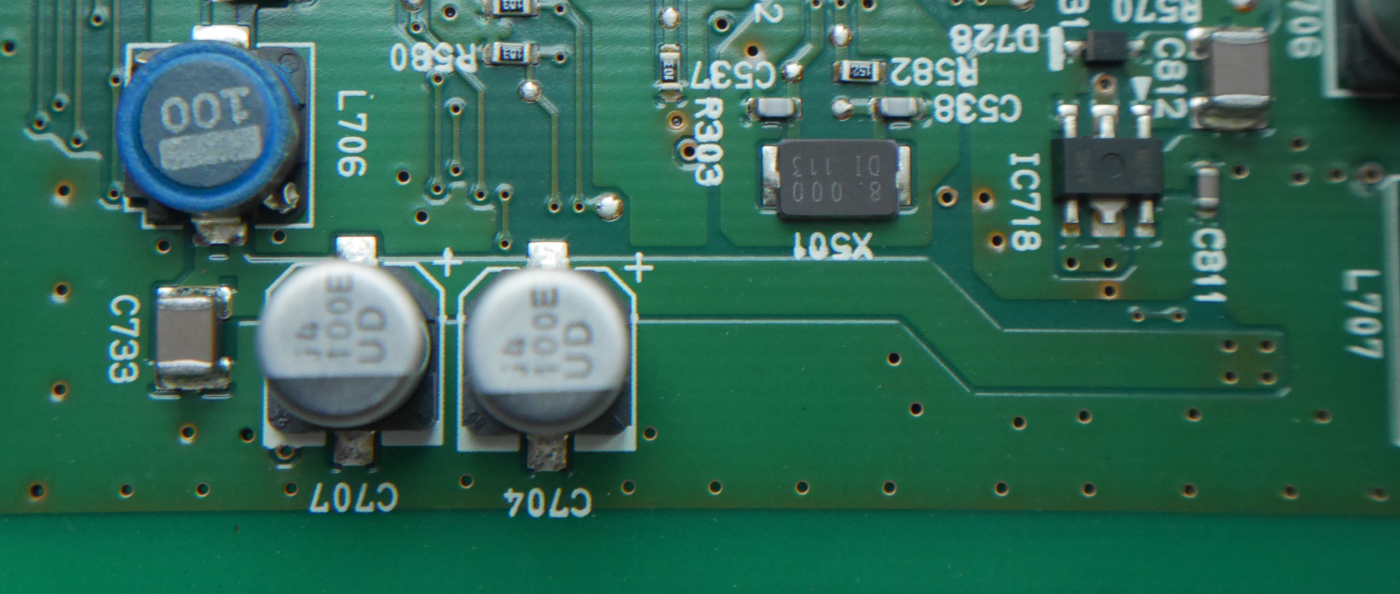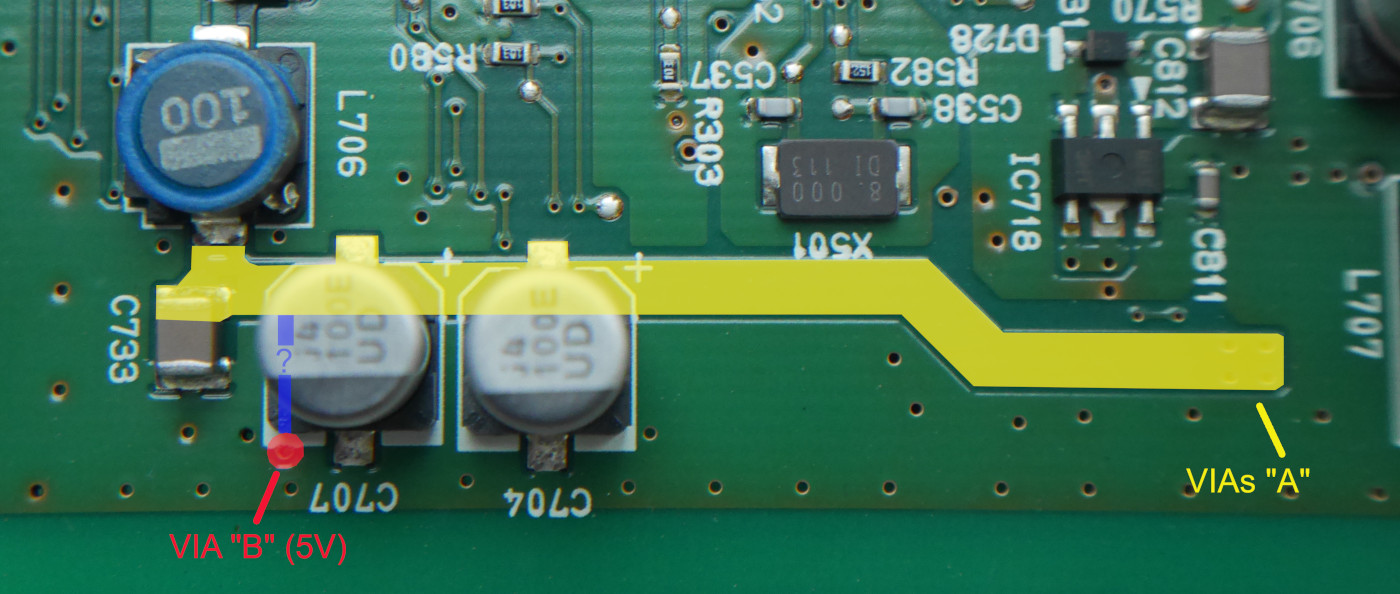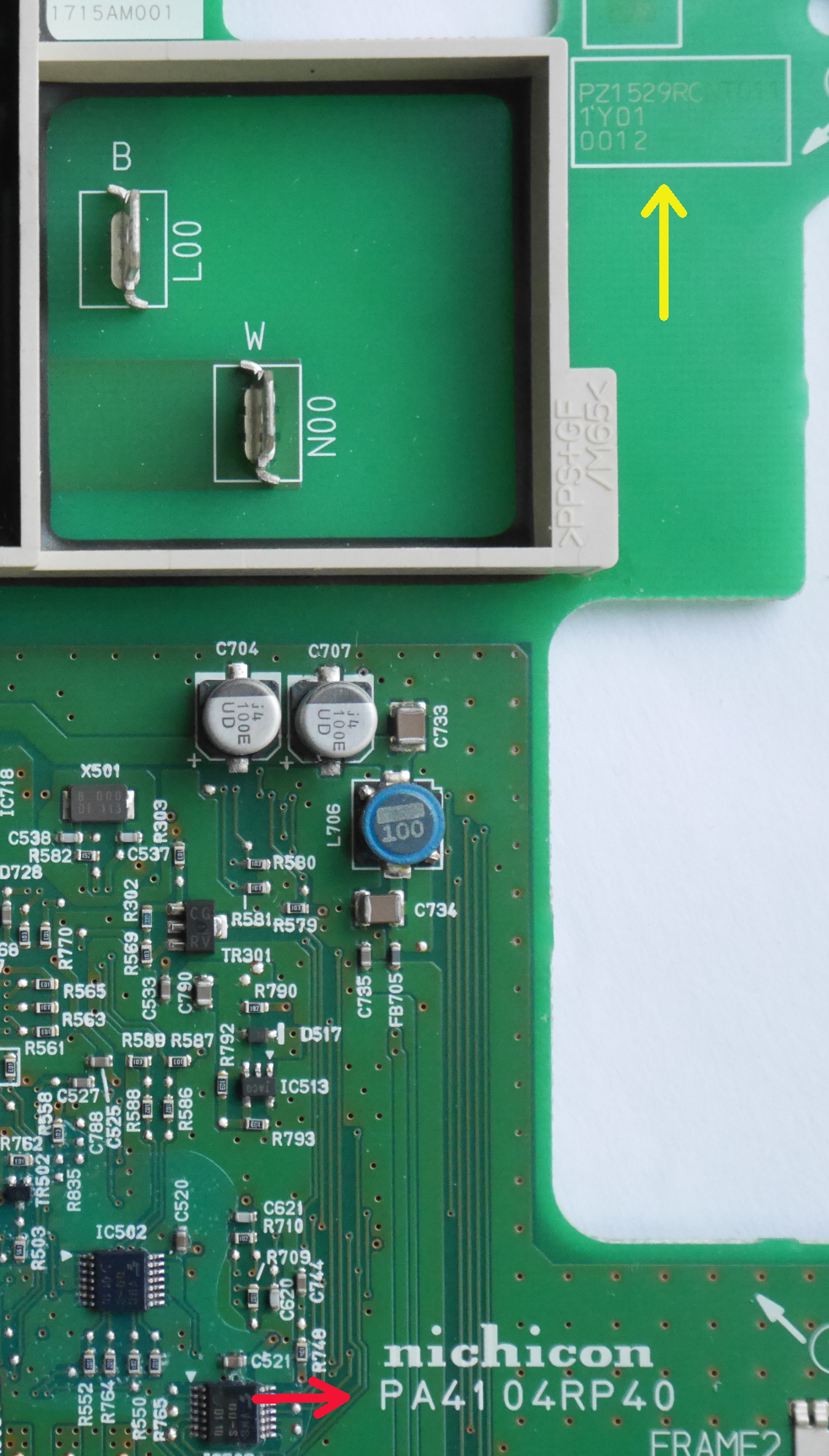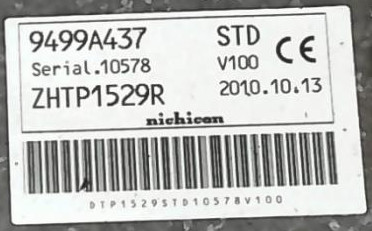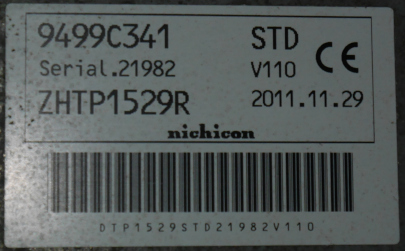iOnico
Member
The connection between R720 and R721 is ok. There was a connection remaining from R720 to Ground, but after removing the resistor the Ground solder pad of R720 is now gone. I'll have to bridge it with solder or a wire when replacing the resistor (see 3rd picture below).
Besides of the R720 I also removed the Ground layer in the area that was marked in red in my last post to be sure that there wasn't a short in this area. Now I can say: there wasn't a short in this area. The VIAs in this area still have a Ground signal that must come from the top side of the board.
I traced the way of the 5V-signal from the TR710 to the VCC of the IC509 based on what you have told me. The following pictures are showing it:
Starting on bottom side...
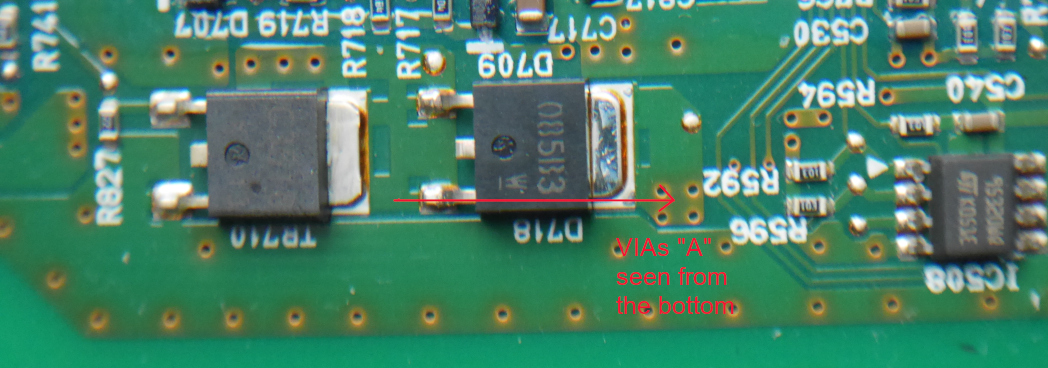
... continuing on the top side... [edit: VIA "C" isn't a VIA, kiev corrected this wrong assumption in the next post]
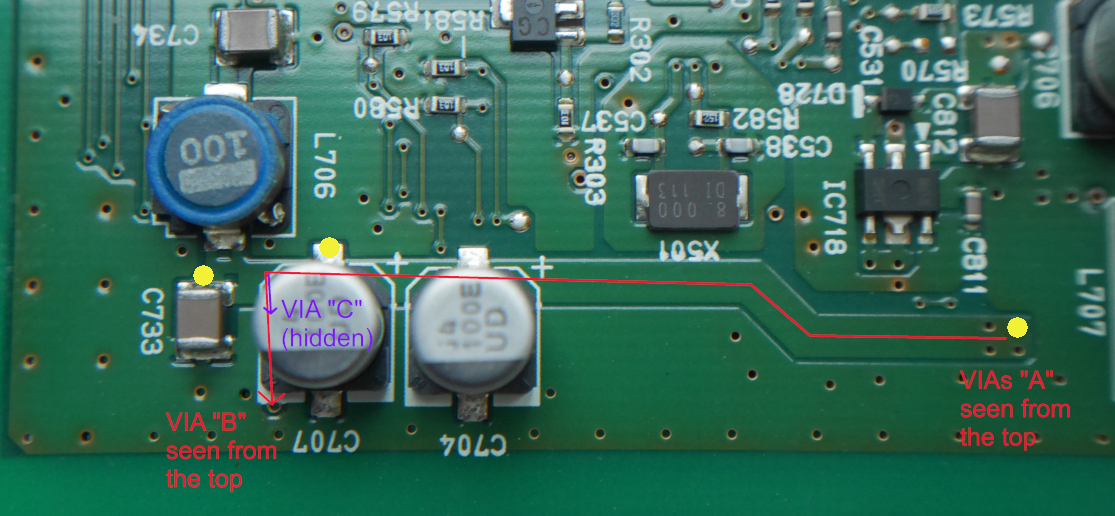
... ending on the bottom side again. [edit: VIA "C" isn't a VIA, kiev corrected this wrong assumption in the next post]
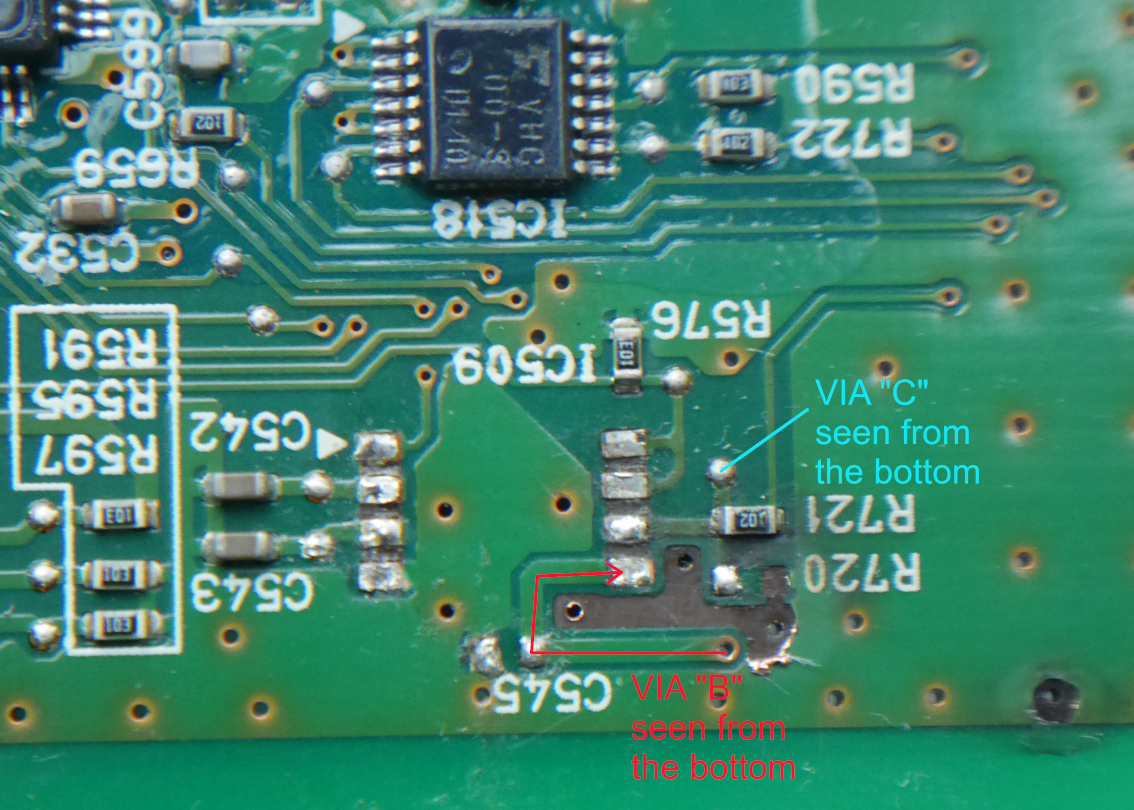
Taking some measures on this circuit, I noticed a high resistance (1.125 kΩ measuring in current flow direction or 8.96 kΩ measuring in opposite direction of current flow) measuring between VIA B and the places marked by a yellow circle in the second picture (top side). The resistance between VIA B and VIA C (measure taken on the bottom side of the board) is 1.185 kΩ. The resistance between VIA C and VIA A (measure taken on the bottom side of the board) is 2.7 kΩ when measured in opposite direction of current flow, or 10 kΩ when measured in current flow direction. I don't see a good reason why there would be high resistance in a supply line. The VIA C and the trace going to the VIA B are both under the C707. [edit: VIA C isn't a VIA, kiev corrected this wrong assumption in the next post] So either the traces don't run as I believe they are running, or there is some sort of resistance there that had been designed to be there (under C707! - seems unlikely...), or there has been some damage, what doesn't seem unlikely as two of the 3 impacts are directly on the other side of the board.
I also took some resistance measures on the TR710 but it doesn't seem suspect (yet). I measured 220 Ω between both legs, 530 Ω between the metal tab and the ground leg and 780 Ω between the metal tab and the other leg. IC509's VCC to the metal tab of TR710 measures 533 Ω, what is consistent with the 530 Ω between the metal tab and the ground leg of TR710 + 3 or 4 Ω between IC509's VCC and Ground.
Thanks for the soldering trick. I struggled less today when I've removed the R720, but it might have been luck or because one side wasn't really holding it any more. I have some solder braid around but it isn't absorbing the solder. Maybe it misses some flux or my soldering iron isn't powerful enough to heat up enough braid and solder. I'm a bit more successful with the (manual) solder sucker, but it's not the tool to get the little rest of solder away or to be used in very narrow spaces. The other difficulty with narrow spaces is that I'm always afraid to create solder joints where there shouldn't be one (neighbour parts and legs, ...).
Besides of the R720 I also removed the Ground layer in the area that was marked in red in my last post to be sure that there wasn't a short in this area. Now I can say: there wasn't a short in this area. The VIAs in this area still have a Ground signal that must come from the top side of the board.
I traced the way of the 5V-signal from the TR710 to the VCC of the IC509 based on what you have told me. The following pictures are showing it:
Starting on bottom side...

... continuing on the top side... [edit: VIA "C" isn't a VIA, kiev corrected this wrong assumption in the next post]

... ending on the bottom side again. [edit: VIA "C" isn't a VIA, kiev corrected this wrong assumption in the next post]

Taking some measures on this circuit, I noticed a high resistance (1.125 kΩ measuring in current flow direction or 8.96 kΩ measuring in opposite direction of current flow) measuring between VIA B and the places marked by a yellow circle in the second picture (top side). The resistance between VIA B and VIA C (measure taken on the bottom side of the board) is 1.185 kΩ. The resistance between VIA C and VIA A (measure taken on the bottom side of the board) is 2.7 kΩ when measured in opposite direction of current flow, or 10 kΩ when measured in current flow direction. I don't see a good reason why there would be high resistance in a supply line. The VIA C and the trace going to the VIA B are both under the C707. [edit: VIA C isn't a VIA, kiev corrected this wrong assumption in the next post] So either the traces don't run as I believe they are running, or there is some sort of resistance there that had been designed to be there (under C707! - seems unlikely...), or there has been some damage, what doesn't seem unlikely as two of the 3 impacts are directly on the other side of the board.
I also took some resistance measures on the TR710 but it doesn't seem suspect (yet). I measured 220 Ω between both legs, 530 Ω between the metal tab and the ground leg and 780 Ω between the metal tab and the other leg. IC509's VCC to the metal tab of TR710 measures 533 Ω, what is consistent with the 530 Ω between the metal tab and the ground leg of TR710 + 3 or 4 Ω between IC509's VCC and Ground.
Thanks for the soldering trick. I struggled less today when I've removed the R720, but it might have been luck or because one side wasn't really holding it any more. I have some solder braid around but it isn't absorbing the solder. Maybe it misses some flux or my soldering iron isn't powerful enough to heat up enough braid and solder. I'm a bit more successful with the (manual) solder sucker, but it's not the tool to get the little rest of solder away or to be used in very narrow spaces. The other difficulty with narrow spaces is that I'm always afraid to create solder joints where there shouldn't be one (neighbour parts and legs, ...).





